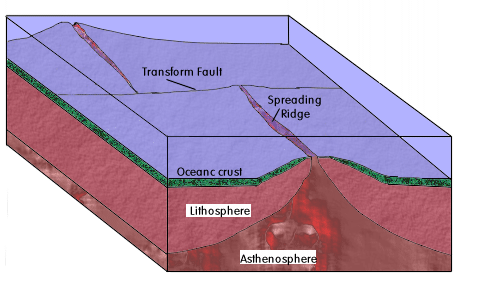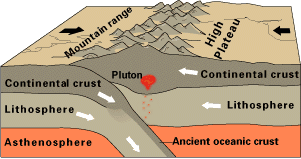Plate Tectonics: An Introduction
About the author

Jon
University of Edinburgh
Introduction
Plate tectonics is the theory that underpins most of modern geology. The basic idea is that the surface of the Earth is made up of several segments - plates. These plates move around the globe while being created and destroyed at their margis. This theory helps to explain many things, such as the rock types that indicate desert climates in north England. Rather than have to move the climatic belts, it is the continent itself that has moved. Other things that plate tectonics explains is the shape of the continents, the fact that the coastlines of Africa and South America fit together. This is obvious looking at any map (Figure one). The boundaries of the plates, regardless of type are marked by earthquakes (the black dots) and some by volcanoes.

Figure 1: A map of the plates on the Earth. Modified from Plummer and McGeary (1997).
The Lithosphere
The plate in plate tectonics is the known as the lithosphere. The word lithosphere means "rock layer". The lithosphere is made up of the crust and the uppermost mantle (Figure 2). It averages about 100km in thickness. The layer below the lithosphere is the asthenosphere - which means "weak layer". The lithosphere effectively "slides" over this weak layer. There are two types of lithosphere: continental and oceanic. Each has it's own set of unique features and structure. Both types of lithosphere can exist within a single plate, for example the North American plate has both continental and oceanic lithosphere. However, the continental lithosphere can be much thicker than 100km, especially in old, stable, Precambrian areas. Under these areas, roots or keels form, sticking the continental crust into the mantle. The lithosphere is generally rigid (that is, it cracks and does not bend).

Figure 2: Lithospheric structure. Left shows the oceanic lithosphere; the right shows the continental lithosphere. Redrawn from Keary and Vine (1996).
Constructive Plate Margins
Constructive plate margins, also known as divergent plate margins or mid-ocean ridges are where plates are created. At a mid-ocean ridge, magma wells up creating new oceanic lithosphere. The ridges circle the planet, occurring in all the major oceans.
A mid-ocean ridge consists of sections of ridge separated by transform faults (Figure 3). The ridge is elevated with respect to the ocean floor due to the high heat flow beneath. The heat flow elevates the ridge due to the associated reduction in density. They are typically 2km higher than the typical ocean depth of 4km. At the transform faults, the depth does increase slightly.
As with all plate margins, constructive plate margins are associated with seismicity. However, the earthquakes on a mid-ocean ridge are far from any human life and usually low in magnitude, and therefore not dangerous. They are also shallow and concentrated around the transform faults.
The magma that wells up at ridges does not vary in composition from ridge to ridge. It is always basic (tholeitiic) in composition. It forms structures called pillow lavas (see the this picture, for example). The dykes and cumulates in the lithosphere are also basic in composition.

Figure 3: A mid ocean ridge, which is a constructive plate boundary.
Destructive Plate Margins
A destructive plate margin or subduction zone is where plates are destroyed. They are the source of major earthquakes and volcanism, especially around the Pacific where they form "The Ring of Fire". There are three types of destructive margins - those where oceanic lithosphere meets oceanic lithosphere, continent-continent collisions and that where continental lithosphere meets oceanic lithosphere. The features in each case are similar. However, a continent-continent collision results in little or no volcanism. There three types of destructive plate margins (Figure 4), described below.
The sequence of the figures below is not coincidental. The only lithosphere that can usually subduct is oceanic lithosphere, due to its high density compared to continental lithosphere. A typical sequence of events for a subduction are:
- Subduction starts, either ocean-ocean or ocean-continent.
- If subduction started with ocean-ocean, then it may progress to ocean-continent if one of the oceanic plates has some continental lithosphere in it.
- If both plates have continental lithosphere within, then continent-continent collision will occur.
Continent-continent collision results in mountain building or orogenesis.
 |
Ocean-ocean collision. Note the trench and volcanic arc. Japan is an example of such an island arc. |
 |
Ocean-continent collision. The trench is still there, but the volcanism occurs on the continental crust. The Andes mountains are an example of this situation. |
 |
The two plates override each other, thickening the lithosphere and producing mountains. The Himalayas are a good example of this. All mountain chains are formed in this way. Note the lack of volcanoes. |
Figure 4: The three types of destructive margin. Modified from USGS.
The key features of a subduction zone are a trench and volcanic arc. The trenches form the deepest parts of the ocean. They are usually filled in with sediment derived from the continent and "scraped" off the subducting oceanic plate. This sediment package is called the accretionary prism. The volcanoes in destructive plate margins are andesitic in ocean-ocean collisions and andesitic to granitic in ocean-continent collisions. Earthquakes in a destructive margin are much larger and can occur at all depths. They trace the path of the subducting slab as it plunges into the mantle. This curve that the earthquakes trace out is called the Benioff Zone.
Conservative Plate Margins
The conservative plate margin is easiest to understand. It is a strike-slip type fault where two adjacent plates move alongside each other. The San Andreas fault is the most well known example and is the boundary between the North American plate and the Pacific plate. Located in California, USA, it passes directly through San Francisco. It has caused many earthquakes since humans inhabited the region with the biggest (in historical records) occuring on the 18th April, 1908. Over 700 people died.
The fault itself is around 30 million years old and has moved a total distance of some 300km in this time (around an average of 10mm a year).
Conclusion
Plate tectonics if the framework for all modern geology. The theory states that the earth's surface is made up of several plates that move around, being created and destroyed at the plate margins. This results in earthquakes and, on some types of margins, volcanoes. The three types of margin are conservative, constructive or destructive. Constructive margins are the site of mid-ocean ridges. Destructive margins form subduction zone where a plate is pushed underneath another.
References
P. Keary & F.J Vine, 1996. Global Tectonics.
C. Plummer, D. McGeary, 1997. Physical Geology.
 GeologyRocks
GeologyRocks Send to friend
Send to friend